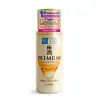What's inside
What's inside
 Key Ingredients
Key Ingredients

 Benefits
Benefits

 Concerns
Concerns

 Ingredients Side-by-side
Ingredients Side-by-side

Water
Skin ConditioningGlycerin
HumectantDipropylene Glycol
HumectantParaffinum Liquidum
EmollientDimethicone
EmollientCetyl Alcohol
EmollientTriethylhexanoin
MaskingHydrogenated Poly(C6-12 Olefin)
Skin ConditioningPalmitic Acid
EmollientCetyl Phosphate
EmulsifyingArginine
MaskingPhenoxyethanol
PreservativeSodium Hyaluronate
HumectantCarbomer
Emulsion StabilisingDisodium EDTA
Hydroxyethylcellulose
Emulsion StabilisingAllantoin
Skin ConditioningButylene Glycol
HumectantHydrolyzed Hyaluronic Acid
HumectantLactococcus/Hyaluronic Acid Ferment Filtrate
Aphanothece Sacrum Exopolysaccharides
AbsorbentHydroxypropyltrimonium Hyaluronate
Hydrolyzed Sodium Hyaluronate
Skin ConditioningSodium Acetylated Hyaluronate
HumectantSodium Hyaluronate Crosspolymer
HumectantPentylene Glycol
Skin ConditioningWater, Glycerin, Dipropylene Glycol, Paraffinum Liquidum, Dimethicone, Cetyl Alcohol, Triethylhexanoin, Hydrogenated Poly(C6-12 Olefin), Palmitic Acid, Cetyl Phosphate, Arginine, Phenoxyethanol, Sodium Hyaluronate, Carbomer, Disodium EDTA, Hydroxyethylcellulose, Allantoin, Butylene Glycol, Hydrolyzed Hyaluronic Acid, Lactococcus/Hyaluronic Acid Ferment Filtrate, Aphanothece Sacrum Exopolysaccharides, Hydroxypropyltrimonium Hyaluronate, Hydrolyzed Sodium Hyaluronate, Sodium Acetylated Hyaluronate, Sodium Hyaluronate Crosspolymer, Pentylene Glycol
Centella Asiatica Extract 50%
CleansingWater
Skin ConditioningCaprylic/Capric Triglyceride
MaskingMacadamia Ternifolia Seed Oil
EmollientSqualane
EmollientButylene Glycol
HumectantCetearyl Alcohol
EmollientGlycerin
HumectantNiacinamide
Smoothing1,2-Hexanediol
Skin ConditioningPotassium Cetyl Phosphate
EmulsifyingBehenic Acid
CleansingBetaine
HumectantTromethamine
BufferingHydrogenated Lecithin
EmulsifyingButyrospermum Parkii Butter
Skin ConditioningPalmitic Acid
EmollientStearic Acid
CleansingCandida Bombicola/Glucose/Methyl Rapeseedate Ferment
AntimicrobialCaprylyl Glycol
EmollientOryza Sativa Germ Oil
EmollientCocos Nucifera Oil
MaskingTremella Fuciformis Extract
HumectantSodium Hyaluronate
HumectantPerilla Ocymoides Seed Extract
AntioxidantBeta-Glucan
Skin ConditioningCarbomer
Emulsion StabilisingXanthan Gum
EmulsifyingHydroxyethylcellulose
Emulsion StabilisingSodium Carbomer
Emulsion StabilisingAdenosine
Skin ConditioningAsiaticoside
AntioxidantAsiatic Acid
Skin ConditioningPhytosphingosine
Skin ConditioningCeramide NP
Skin ConditioningMadecassic Acid
Skin ConditioningMyristic Acid
CleansingArachidic Acid
CleansingCentella Asiatica Extract 50%, Water, Caprylic/Capric Triglyceride, Macadamia Ternifolia Seed Oil, Squalane, Butylene Glycol, Cetearyl Alcohol, Glycerin, Niacinamide, 1,2-Hexanediol, Potassium Cetyl Phosphate, Behenic Acid, Betaine, Tromethamine, Hydrogenated Lecithin, Butyrospermum Parkii Butter, Palmitic Acid, Stearic Acid, Candida Bombicola/Glucose/Methyl Rapeseedate Ferment, Caprylyl Glycol, Oryza Sativa Germ Oil, Cocos Nucifera Oil, Tremella Fuciformis Extract, Sodium Hyaluronate, Perilla Ocymoides Seed Extract, Beta-Glucan, Carbomer, Xanthan Gum, Hydroxyethylcellulose, Sodium Carbomer, Adenosine, Asiaticoside, Asiatic Acid, Phytosphingosine, Ceramide NP, Madecassic Acid, Myristic Acid, Arachidic Acid
 Reviews
Reviews

Ingredients Explained
These ingredients are found in both products.
Ingredients higher up in an ingredient list are typically present in a larger amount.
Butylene Glycol (or BG) is used within cosmetic products for a few different reasons:
Overall, Butylene Glycol is a safe and well-rounded ingredient that works well with other ingredients.
Though this ingredient works well with most skin types, some people with sensitive skin may experience a reaction such as allergic rashes, closed comedones, or itchiness.
Learn more about Butylene GlycolCarbomer is a polymer of acrylic acid. Its main role is to create a gel consistency.
A high amount of carbomer can cause pilling or balling up of products. Don't worry, most products contain 1% or less of carbomer.
Glycerin is already naturally found in your skin. It helps moisturize and protect your skin.
A study from 2016 found glycerin to be more effective as a humectant than AHAs and hyaluronic acid.
As a humectant, it helps the skin stay hydrated by pulling moisture to your skin. The low molecular weight of glycerin allows it to pull moisture into the deeper layers of your skin.
Hydrated skin improves your skin barrier; Your skin barrier helps protect against irritants and bacteria.
Glycerin has also been found to have antimicrobial and antiviral properties. Due to these properties, glycerin is often used in wound and burn treatments.
In cosmetics, glycerin is usually derived from plants such as soybean or palm. However, it can also be sourced from animals, such as tallow or animal fat.
This ingredient is organic, colorless, odorless, and non-toxic.
Glycerin is the name for this ingredient in American English. British English uses Glycerol/Glycerine.
Learn more about GlycerinHydroxyethylcellulose is used to improve the texture of products. It is created from a chemical reaction involving ethylene oxide and alkali-cellulose. Cellulose is a sugar found in plant cell walls and help give plants structure.
This ingredient helps stabilize products by preventing ingredients from separating. It can also help thicken the texture of a product.
This ingredient can also be found in pill medicines to help our bodies digest other ingredients.
Learn more about HydroxyethylcellulosePalmitic Acid is a fatty acid naturally found in our skin and in many plant and animal sources. In cosmetics, it is usually derived from palm oil. It serves many purposes in skincare, acting as a cleanser, emollient, and emulsifier.
As an emollient, palmitic acid helps soften and smooth the skin by preventing water loss. In cleansers, it helps remove oil and dirt while creating foam.
Its emulsifying properties help stabilize products by keeping water and oil-based ingredients from separating.
This may not be suitable for fungal acne-prone skin, as fatty acids like this can sometimes trigger breakouts in sensitive individuals.
Learn more about Palmitic AcidSodium Hyaluronate is hyaluronic acid's salt form. It is commonly derived from the sodium salt of hyaluronic acid.
Like hyaluronic acid, it is great at holding water and acts as a humectant. This makes it a great skin hydrating ingredient.
Sodium Hyaluronate is naturally occurring in our bodies and is mostly found in eye fluid and joints.
These are some other common types of Hyaluronic Acid:
Learn more about Sodium HyaluronateWater. It's the most common cosmetic ingredient of all. You'll usually see it at the top of ingredient lists, meaning that it makes up the largest part of the product.
So why is it so popular? Water most often acts as a solvent - this means that it helps dissolve other ingredients into the formulation.
You'll also recognize water as that liquid we all need to stay alive. If you see this, drink a glass of water. Stay hydrated!
Learn more about Water